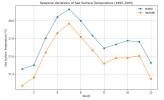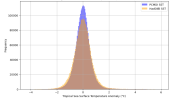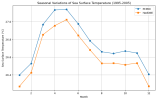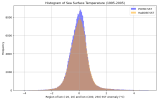Dear all,
I am currently evaluating two SST datasets, HadOIBl-SST and PCMDI-SST. While PCMDI-SST was based on observational data and explicitly designed for AMIP runs, I noticed that CESM2 predominantly uses the HadOIBl-SST dataset.
I looked at both datasets, and the most significant discrepancies between these datasets are in temperature readings over land, which has added to my confusion.
And I wonder why the prescribed land temperature in SST files for HadOIBl looks strange as horizontal bands.
Could anyone with experience using these datasets provide insights into their specific use cases, advantages, and why one might be preferred over the other?
Any help and suggestions would be greatly appreciated!
I am currently evaluating two SST datasets, HadOIBl-SST and PCMDI-SST. While PCMDI-SST was based on observational data and explicitly designed for AMIP runs, I noticed that CESM2 predominantly uses the HadOIBl-SST dataset.
I looked at both datasets, and the most significant discrepancies between these datasets are in temperature readings over land, which has added to my confusion.
And I wonder why the prescribed land temperature in SST files for HadOIBl looks strange as horizontal bands.
Could anyone with experience using these datasets provide insights into their specific use cases, advantages, and why one might be preferred over the other?
Any help and suggestions would be greatly appreciated!




